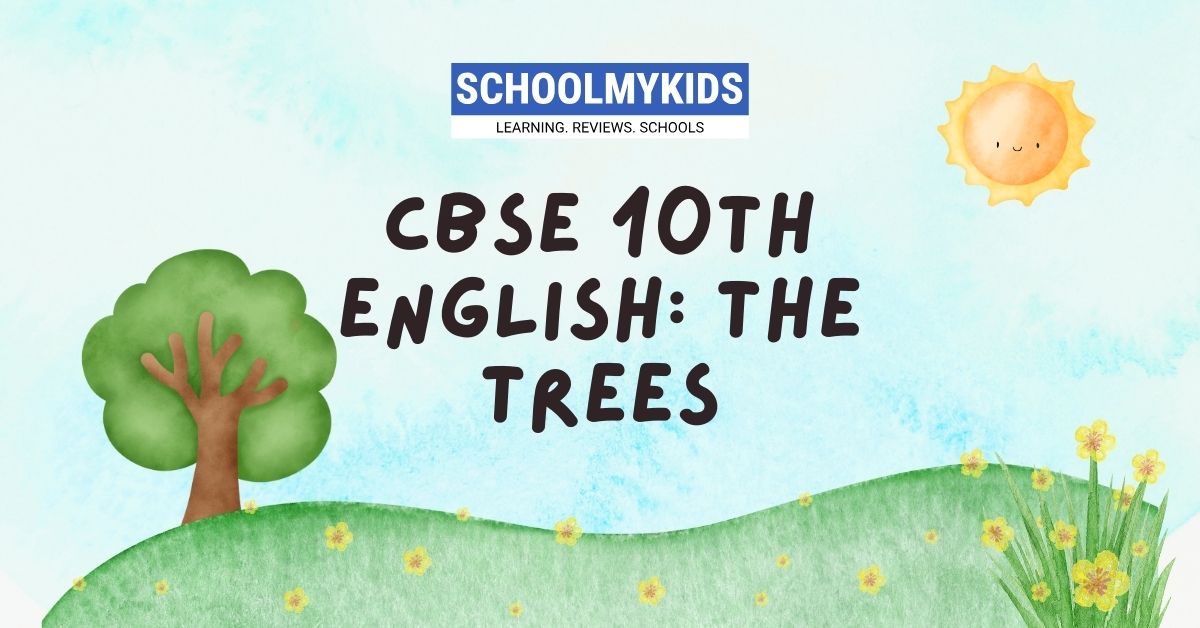“The Trees” by Adrienne Rich is a poignant poem included in the CBSE 10th board English syllabus. It explores themes of freedom, nature, and human impact on the environment. Through vivid imagery and personification, Rich narrates the struggle of trees to break free from confinement and reclaim their place in nature.
The poem opens with the depiction of trees kept indoors, struggling to escape their artificial environment. As the poem progresses, the trees are described as breaking through the glass and moving towards the forest, symbolizing their inherent need for freedom. The trees’ liberation mirrors the broader theme of nature reclaiming its space from human encroachment.
Rich’s use of language evokes a sense of urgency and determination, as the trees’ movement becomes a metaphor for resilience and the relentless force of nature. The poem concludes with the trees finally merging with the forest, underscoring the triumph of nature over human-imposed limitations.
Analysis
Adrienne Rich’s “The Trees” is a masterful blend of environmental commentary and poetic expression. The trees symbolize the broader natural world, and their struggle to escape confinement reflects the ongoing conflict between nature and human civilization.
Rich employs personification, giving the trees human-like qualities to evoke empathy and highlight their struggle. The imagery of trees breaking through glass is particularly powerful, serving as a metaphor for nature’s unstoppable force. The poem’s structure, with its steady progression from confinement to liberation, mirrors the natural cycle of growth and renewal.
Important Questions with Explanations
- What is the central theme of “The Trees” by Adrienne Rich?
- The central theme is the conflict between nature and human civilization, highlighting the struggle for freedom and the resilience of nature.
- How does Adrienne Rich use personification in the poem?
- Rich personifies the trees, giving them human-like qualities such as the ability to struggle and escape, to evoke empathy and illustrate their plight.
- Describe the imagery used in the poem and its significance.
- The imagery of trees breaking through glass symbolizes the powerful and unstoppable force of nature reclaiming its space.
- What does the movement of trees towards the door symbolize?
- It symbolizes the trees’ yearning for freedom and their natural place in the world, free from human constraints.
- How does the poem reflect the conflict between nature and human civilization?
- It reflects this conflict through the depiction of trees struggling to escape confinement and return to their natural environment.
- Analyze the poet’s tone throughout the poem.
- The poet’s tone is urgent and determined, emphasizing the relentless and inevitable movement of nature towards freedom.
- What literary devices are prominently used in “The Trees”?
- The poem prominently uses personification, imagery, and metaphor to convey its themes and messages.
- How does the poem convey a message about environmental conservation?
- It highlights the detrimental impact of human confinement on nature and advocates for the liberation and conservation of the natural world.
- What is the significance of the poem’s ending?
- The ending signifies the triumph of nature as the trees successfully break free and merge with the forest, highlighting the eventual victory of natural forces.
- Discuss how “The Trees” is relevant to contemporary environmental issues.
- The poem is relevant today as it addresses themes of environmental degradation, conservation, and the need for sustainable interaction with nature.
- How does Rich create a sense of movement in the poem?
- Through dynamic imagery and action verbs, Rich creates a sense of movement as the trees transition from confinement to liberation.
- What role does the setting play in “The Trees”?
- The indoor setting represents artificial confinement, while the forest symbolizes natural freedom, underscoring the central conflict.
- How does the poet use contrast in the poem?
- Rich contrasts the confined, artificial indoor space with the open, natural environment of the forest to highlight the trees’ struggle.
- What emotions does the poem evoke in the reader?
- The poem evokes emotions of empathy, urgency, and hope as readers witness the trees’ struggle and eventual triumph.
- Explain the metaphor of the trees breaking through glass.
- This metaphor represents the breaking of barriers and the unstoppable force of nature reclaiming its rightful place.
- How does “The Trees” reflect Adrienne Rich’s views on nature?
- The poem reflects Rich’s advocacy for environmental preservation and her belief in nature’s resilience and power.
- Discuss the structure of the poem and its impact on the overall message.
- The structure, with a clear progression from confinement to liberation, reinforces the theme of nature’s inevitable victory over human constraints.
- How does the poem address the idea of freedom?
- It addresses freedom by depicting the trees’ struggle and eventual escape from confinement, symbolizing the broader concept of liberation.
- What does the imagery of the forest represent in the poem?
- The forest represents the natural, rightful place of the trees and symbolizes freedom, growth, and harmony with nature.
- How can “The Trees” inspire contemporary readers to engage in environmental activism?
- By highlighting the struggle and resilience of nature, the poem can inspire readers to advocate for environmental conservation and sustainable practices.









Be the first one to comment on this story.